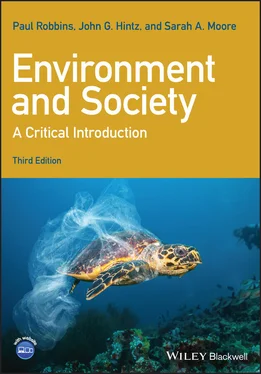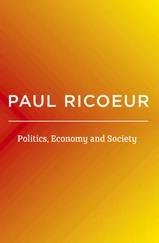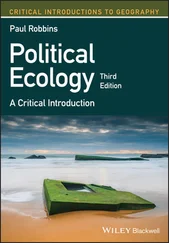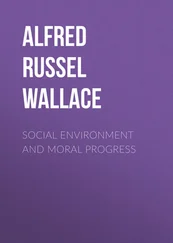3 Who has a larger ecological footprint, you or a subsistence fisher in coastal Bangladesh? Explain.
4 How can population growth force a transition from extensive agriculture to intensive agriculture? How does this transition often lead to innovation?
5 What factors led to the dramatic decrease in population growth rates in Kerala, India? Compare the case of Kerala to India’s national population control program put into place in the 1970s.
Exercise 2.1 What Is Your Ecological Footprint?
Go to http://myfootprint.org/enand read about ecological footprint analysis. Take the ecological footprint quiz, noting your responses and results. Now take the quiz again, three more times. Each time, change only ONE of your answers from your original answers, as if you had changed one of your own behaviors. Make note of: How does the changed behavior change the resulting final footprint? By how much does the footprint change? And, which particular changes appear to get the most ecological benefit?
What was your original footprint? How did it compare to the national and global averages? In what categories were you higher or lower than this average? How many Earths would be required to support a planet in which everyone lived as you do? Why do you think your overall impact is higher than/lower than/equal to the average? What factors in your life, background, or current situation account for your overall footprint? Will they change in the future? In what direction?
What three changes did you introduce in your proposed behaviors in the three further quizzes? Which of these changes had the greatest impact on your footprint? Which of these is actually the most feasible or likely change (i.e. which would be easiest)? Is the easiest change the one that would make the biggest difference in terms of ecological benefits? Why or why not? What makes some choices more difficult than others? In light of this, to what degree do you feel that global population is a factor in environmental change, relative to consumption, affluence, and lifestyle?
Exercise 2.2 Where are Fertility Rates High? Why?
Visit the Population Reference Bureau’s data hub at https://www.prb.org/data. Using the tools you find there (which include tables, maps, and other resources), research the Total Fertility Rate of four or five countries, along with some other key indicators, like development, wealth, education for women. Where are large families (fertility rates > 3.5) more normal and why? Where are fertility rates lower (<2.5) and why? What possible support, policies, or interventions might realistically accelerate a decrease in fertility in high-growth countries?
Exercise 2.3 Too Few People?
As of 2012, the Birth Rates in Japan and Germany were 9 per thousand and 8 per thousand respectively. These are very low rates and portend an overall “baby bust” as people have fewer children every year. Can you think of problems that might emerge in these places from having too few children? What challenges might such countries face in the next 20 years? How might they be solved?
1 Boserup, E. (1965). Conditions of Agricultural Growth: The Economics of Agrarian Change under Population Pressure. Chicago, IL: Aldine.
2 Chambers, N., Simmons, C., Wackernagel, M. et al. (2002). Sharing Nature’s Interest. London: Earthscan.
3 Commoner, B. (1988). The environment. In: Crossroads: Environmental Priorities for the Future. (ed. P. Borelli), 121–169. Washington, DC: Island Press.
4 Demeny, P. (1990). Population. In: The Earth as Transformed by Human Action (ed. B.L. Turner, W.C. Clark, R. Kates et al.), 41–54. Cambridge: Cambridge University Press.
5 Ehrlich, P.R. and Holdren, J. (1974). Impact of population growth. Science 171 (3977): 1212–1217.
6 European Commission and the Netherlands Environmental Assessment Agency. (2018). Emissions Database for Global Atmospheric Research (EDGAR) 2018. https://www.eea.europa.eu/themes/air/links/data-sources/emission-database-for-global-atmospheric(accessed 28 July 2021).
7 Hartmann, B. (1995). Reproductive Rights and Wrongs: The Global Politics of Population Control. Boston, MA: South End Press.
8 International Monetary Fund. (2021). World economic outlook. https://www.imf.org/external/datamapper/datasets/WEO(accessed 28 July 2021).
9 Malthus, T.R. (1992). An Essay on the Principle of Population (Selected and Introduced by D. Winch). Cambridge: Cambridge University Press.
10 Newbold, B.K. (2010). Population Geography: Tools and Issues. Oxford: Rowman & Littlefield.
11 Parayil, G. (ed.) (2000). Kerala: The Development Experience. London: Zed Books.
12 Perz, S.G. (2007). Grand theory and context-specificity in the study of forest dynamics: Forest transition theory and other directions. Professional Geographer 59 (1): 105–114.
13 Population Reference Bureau (2008). World Population Data Sheet. www.prb.org/Publications/Datasheets/2008/2008wpds.aspx(accessed 7 October 2009).
14 Robbins, P. and Smith, S.H. (2017). Baby bust: Towards political demography. Progress in Human Geography 41 (2): 199–219.
15 United Nations. (2019). Revision of world population prospects. UN Department of Economic and Social Affairs. https://population.un.org/wpp/ (accessed 28 July 2021).
16 World Bank (2012). World development indicators. http://data.worldbank.org/data-catalog/world-development-indicators(accessed 14 August 2013).
17 World Bank Group. (2014). Energy use (kg of oil equivalent per capita). https://data.worldbank.org/indicator/EG.USE.PCAP.KG.OE(accessed 28 July 2021).
18 World Bank Group. (2018). Forest area (% of land area). https://data.worldbank.org/indicator/AG.LND.FRST.ZS(accessed 28 July 2021).
1 Ehrlich, P.R. and Ehrlich A.H. (1991). The Population Explosion. New York: Simon and Schuster.
2 Kates, C.A. (2004). Reproductive liberty and overpopulation. Environmental Values 13 (1): 51–79.
3 Lambin, E.F., Turner B.L., Geist, H.J. et al. (2001). The causes of land-use and land-cover change: Moving beyond the myths. Global Environmental Change – Human and Policy Dimensions 11 (4): 261–269.
4 Mamdani, M. (1972). The Myth of Population Control: Family, Caste, and Class in an Indian Village. New York: Monthly Review Press.
5 Patel, T. (1994). Fertility Behavior: Population and Society in a Rajasthani Village. Bombay: Oxford University Press.
6 Robbins, P. (2016). After the baby bust: The politics and ecology of zero population growth. The Breakthrough Journal, 6. https://thebreakthrough.org/journal/issue-6/after-the-baby-bust(accessed 10 March 2021).
7 Sayre, N.F. (2008). The genesis, history, and limits of carrying capacity. Annals of the Association of American Geographers 98 (1): 120–134.
8 United Nations. (2011). As world passes 7 billion milestone, UN urges action to meet key challenges, UN News Centre. http://www.un.org/apps/news/story.asp?NewsID=40257#.UNtVYndnhnU(accessed 8 August 2013).
9 Warner, S. (2004). Reproductive liberty and overpopulation: A response. Environmental Values 13 (3): 393–399.
3 Markets and Commodities
Keywords
Cap and trade
Coase theorem
Externality
Green certification
Greenwashing
Market failure
Market response model
Monopoly
Monopsony
Transaction costs.

Source : sima/Shutterstock.
The Bet
Читать дальше












